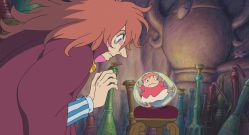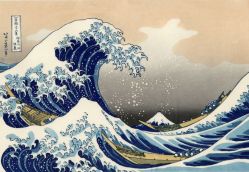Ponyo | reviews, news & interviews
Ponyo
Ponyo
Hayao Miyazaki's modern fairytale about a goldfish who wants to be human is enchanting
Tucked away down a sleepy residential back alley in suburban Tokyo, Studio Ghibli, the headquarters of Hayao Miyazaki, is designed - by the visionary animator himself - in the shape of a boat. When I visited it five years ago, just before the release of his last film, Howl's Moving Castle, the team of young animators all had bowls of fish and terrapins on their desks. The result, Ponyo, is at last about to open in Britain: Miyazaki is a famously slow worker, and the delay has been compounded by a hold-up with distribution. But this irresistible marine fairy-tale is worth the wait.
 Some of the director's films, such as the marvellous Porco Rosso (left) or the Oscar-winning Spirited Away, are less suitable for young children; others, like My Neighbour Totoro or Kiki's Delivery Service, work their magic on audiences of all ages. Ponyo belongs in the latter category. Connoisseurs of the director's work will recognise all his favourite themes - the powerful Miyazaki matriarchs, the shape-shifting spells and curses, the environmental concerns that powered his work long before they became fashionable, the sense of the supernatural embedded deeply in the everyday world. Yet the film is also simple and direct enough to entrance the smallest viewer.
Some of the director's films, such as the marvellous Porco Rosso (left) or the Oscar-winning Spirited Away, are less suitable for young children; others, like My Neighbour Totoro or Kiki's Delivery Service, work their magic on audiences of all ages. Ponyo belongs in the latter category. Connoisseurs of the director's work will recognise all his favourite themes - the powerful Miyazaki matriarchs, the shape-shifting spells and curses, the environmental concerns that powered his work long before they became fashionable, the sense of the supernatural embedded deeply in the everyday world. Yet the film is also simple and direct enough to entrance the smallest viewer.
Behold the wondrously weird opening sequence. On the ocean's bed, among spectral shoals of jellyfish, scurrying bottom-feeders, a vast swarm of goldfish and waves with their own personality (they even have eyes), we discover an androgynous figure, Fujimoto. Part charismatic wizard, part slightly degenerate rock musician, with wild red hair and a candy-striped blazer, he's brewing up potions to save the sea from pollution. When his mischievous daughter, a goldfish named Ponyo, gets trapped in a glass jar and swept away, she's rescued by a small boy, Sosuke, and they fall in love. Does this sound familiar? It's a sweeter, platonic version of Hans Christian Andersen's The Little Mermaid. Ponyo craves to be human and live with her new family in their remote cliff-top cottage, and she manages it briefly through her own mystical powers. But her transformation poses a further threat to the balance of nature. Fujimoto turns up to snatch his daughter back (like many of the director's characters, he's an ambiguous figure, part green crusader, part possessive father who wants to prevent his daughter from growing up). Then the very sea rises to reclaim its own: view the sequence on YouTube here.
Does this sound familiar? It's a sweeter, platonic version of Hans Christian Andersen's The Little Mermaid. Ponyo craves to be human and live with her new family in their remote cliff-top cottage, and she manages it briefly through her own mystical powers. But her transformation poses a further threat to the balance of nature. Fujimoto turns up to snatch his daughter back (like many of the director's characters, he's an ambiguous figure, part green crusader, part possessive father who wants to prevent his daughter from growing up). Then the very sea rises to reclaim its own: view the sequence on YouTube here.
 The film's delight is in its endless wealth of imaginative details. Some of them are surreal: the water pump Fujimoto uses to stop himself from drying out on land, Ponyo's ecstatic run atop a series of giant waves, the candle-powered toy boat in which the children navigate the flood. Some of them are a lovely twist on the everyday: the atmospheric rain-swept fishing village, evoked all in a mauve-turquoise colour palette, or the relationship between Sosuke and his absent seafaring dad, whom he chats to in morse code.
The film's delight is in its endless wealth of imaginative details. Some of them are surreal: the water pump Fujimoto uses to stop himself from drying out on land, Ponyo's ecstatic run atop a series of giant waves, the candle-powered toy boat in which the children navigate the flood. Some of them are a lovely twist on the everyday: the atmospheric rain-swept fishing village, evoked all in a mauve-turquoise colour palette, or the relationship between Sosuke and his absent seafaring dad, whom he chats to in morse code.
Miyazaki champions hand-drawn animation; unlike the sometimes soulless, hyper-real worlds of CGI, his images have a stylised, artisanal quality - his waves evoke classic Japanese woodcuts such as the 19th century Tsunami by Katsushika Hokusai (above left). Yet his work is also steeped in European culture: the clip above has Ponyo (whose birth name, we're told, is Brunhilde) running along the waves to the strains of a Ride of the Valkyrie pastiche.
Much to the dismay of Ghibli fans, Ponyo was dubbed for its US release (in the clip above, one aficionado laments how this version ruins the theme song). Now, I've seen many of Miyazaki's films in both Japanese and English, and it's true that the flavour can be dramatically different. But the dubbing of Ponyo has been (as with earlier Ghibli films) supervised by Pixar's John Lasseter, who professes to be the director's number one fan, and he does once again an extremely professional job here: the voice cast includes Liam Neeson (Fujimoto) and Cate Blanchett (Ponyo's mother, an ocean goddess). If it helps introduce kids to Miyazaki's miraculous world, all the better.
The British distributor, Optimum, has followed a more flexible and imaginative strategy: it is sending cinemas both versions, leaving them to choose which one to show and when (most of them are likely to screen the dubbed print at matinees and the subtitled one in the evenings). Purists can seek out the latter - or, better, and more rewardingly, they can see Ponyo in both versions, again and again.
Ponyo opens on Friday. Official website (US)
more Film
 Fantastic Machine review - photography's story from one camera to 45 billion
Love it or hate it, the photographic image has ensnared us all
Fantastic Machine review - photography's story from one camera to 45 billion
Love it or hate it, the photographic image has ensnared us all
 If Only I Could Hibernate review - kids in grinding poverty in Ulaanbaatar
Mongolian director Zoljargal Purevdash's compelling debut
If Only I Could Hibernate review - kids in grinding poverty in Ulaanbaatar
Mongolian director Zoljargal Purevdash's compelling debut
 The Book of Clarence review - larky jaunt through biblical epic territory
LaKeith Stanfield is impressively watchable as the Messiah's near-neighbour
The Book of Clarence review - larky jaunt through biblical epic territory
LaKeith Stanfield is impressively watchable as the Messiah's near-neighbour
 Blu-ray/DVD: Priscilla
The disc extras smartly contextualise Sofia Coppola's eighth feature
Blu-ray/DVD: Priscilla
The disc extras smartly contextualise Sofia Coppola's eighth feature
 Back to Black review - rock biopic with a loving but soft touch
Marisa Abela evokes the genius of Amy Winehouse, with a few warts minimised
Back to Black review - rock biopic with a loving but soft touch
Marisa Abela evokes the genius of Amy Winehouse, with a few warts minimised
 Civil War review - God help America
A horrifying State of the Union address from Alex Garland
Civil War review - God help America
A horrifying State of the Union address from Alex Garland
 The Teachers' Lounge - teacher-pupil relationships under the microscope
Thoughtful, painful meditation on status, crime, and power
The Teachers' Lounge - teacher-pupil relationships under the microscope
Thoughtful, painful meditation on status, crime, and power
 Blu-ray: Happy End (Šťastný konec)
Technically brilliant black comedy hasn't aged well
Blu-ray: Happy End (Šťastný konec)
Technically brilliant black comedy hasn't aged well
 Evil Does Not Exist review - Ryusuke Hamaguchi's nuanced follow-up to 'Drive My Car'
A parable about the perils of eco-tourism with a violent twist
Evil Does Not Exist review - Ryusuke Hamaguchi's nuanced follow-up to 'Drive My Car'
A parable about the perils of eco-tourism with a violent twist
 Io Capitano review - gripping odyssey from Senegal to Italy
Matteo Garrone's Oscar-nominated drama of two teenage boys pursuing their dream
Io Capitano review - gripping odyssey from Senegal to Italy
Matteo Garrone's Oscar-nominated drama of two teenage boys pursuing their dream
 The Trouble with Jessica review - the London housing market wreaks havoc on a group of friends
Matt Winn directs a glossy cast in a black comedy that verges on farce
The Trouble with Jessica review - the London housing market wreaks havoc on a group of friends
Matt Winn directs a glossy cast in a black comedy that verges on farce
 Silver Haze review - daughters of Albion dealing with damage
Vicky Knight and Esmé Creed-Miles shine in a drama inspired by Knight's tragic past
Silver Haze review - daughters of Albion dealing with damage
Vicky Knight and Esmé Creed-Miles shine in a drama inspired by Knight's tragic past

Add comment